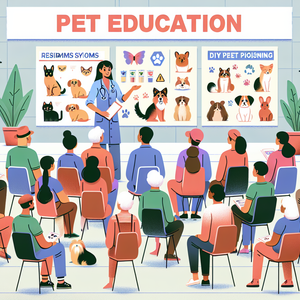The Human Touch in Animal Healthcare: Empathy in an Age of Innovation

At its essence, veterinary medicine is not just about treating animals—it’s about understanding the bond between humans and their pets. Veterinary technologists and technicians serve as the bridge between animals and their owners, offering care that goes beyond medical expertise. They provide comfort to nervous pets and reassurance to owners, especially during emotionally charged occasions like serious diagnoses or end-of-life care. Empathy fosters trust, making it easier for owners to make informed decisions about their pet’s care.
Reading the Unspoken: The Art of Non-Verbal Communication
Veterinary technologists and technicians rely on their expertise, intuition, and observation skills to interpret non-verbal cues from animals, such as changes in behavior or posture, that hint at underlying health issues. They also bridge the gap when pet owners struggle to describe symptoms accurately. This human ability to synthesize diverse information sources is central to effective animal healthcare, something technology cannot replicate.
Compassion in End-of-Life Care
End-of-life care in veterinary medicine requires an unparalleled level of compassion and sensitivity. Veterinary technologists and technicians support pet owners during these heart-wrenching moments, ensuring the animal’s final moments are peaceful and dignified. These deeply human interactions, such as offering comfort and understanding, are irreplaceable and essential in a profession dealing with life and death.
Technology as a Partner, Not a Replacement
AI and robotics in veterinary medicine offer transformative potential, from earlier diagnoses to more precise surgical procedures. However, these tools should augment, not replace, the work of veterinary technologists and technicians. By automating routine tasks, technology allows professionals to focus on providing hands-on care and emotional support, fostering a collaborative future between humans and machines.
The Heart of Veterinary Medicine
Despite the rise of technology, the human touch remains the foundation of veterinary medicine. Veterinary technologists and technicians are not just caregivers but also advocates and companions, connecting emotionally with animals and their owners. The human qualities of empathy, compassion, and emotional intelligence will only grow in importance as technology advances.
The future of veterinary medicine may be high-tech, but it will always depend on the irreplaceable heart of its human practitioners. The human touch is not just an aspect of veterinary medicine—it is its very foundation.
Veterinary Technician – Companion Animal Care
Small animal clinics, emergency veterinary hospitals, and specialty practices
Responsibilities
Assist veterinarians in clinical procedures, including preparing animals for surgery and administering medications.
Monitor animal health and behavior, interpreting non-verbal cues to identify signs of pain or distress.
Provide emotional support and clear communication to pet owners during stressful situations, such as delivering complex diagnoses or explaining treatment plans.
Animal Behavior Specialist – Veterinary Support
Animal rehabilitation centers and specialty clinics
Responsibilities
Assess and interpret animal behavior to support accurate diagnoses and treatment plans, especially for animals exhibiting unusual or problematic behaviors.
Develop behavior modification plans in collaboration with veterinarians to address issues such as anxiety, aggression, or stress.
Educate pet owners on understanding and managing their pets' behavior to improve their overall well-being.
Key Skills
Expertise in animal psychology and non-verbal communication.
Veterinary Surgical Technologist
Veterinary surgical centers, universities, and animal hospitals with advanced surgical facilities
Responsibilities
Prepare animals and surgical areas for procedures, ensuring adherence to strict aseptic techniques.
Operate and maintain advanced surgical equipment, including robotic systems, under the supervision of veterinary surgeons.
Monitor anesthesia and post-operative recovery, providing detailed updates to the veterinary team and pet owners.
Veterinary Hospice and Palliative Care Coordinator
Mobile veterinary services, hospice-focused veterinary practices, and private in-home care providers
Responsibilities
Support families and pets facing chronic illnesses or end-of-life care through empathetic communication and tailored care plans.
Collaborate with veterinarians to manage pain relief protocols, ensuring comfort and dignity for animals in their final stages of life.
Provide counseling and educational resources to pet owners about the hospice and euthanasia process.
Veterinary Diagnostic Imaging Specialist
Specialty veterinary hospitals, diagnostic labs, and academic veterinary institutions
Responsibilities
Operate and interpret results from AI-assisted imaging tools, such as digital radiography, ultrasound, or CT scanning machines.
Collaborate with veterinary teams to contextualize diagnostic imaging findings within the animal's overall clinical presentation.
Stay updated on emerging imaging technologies and train veterinary staff on their effective use.


